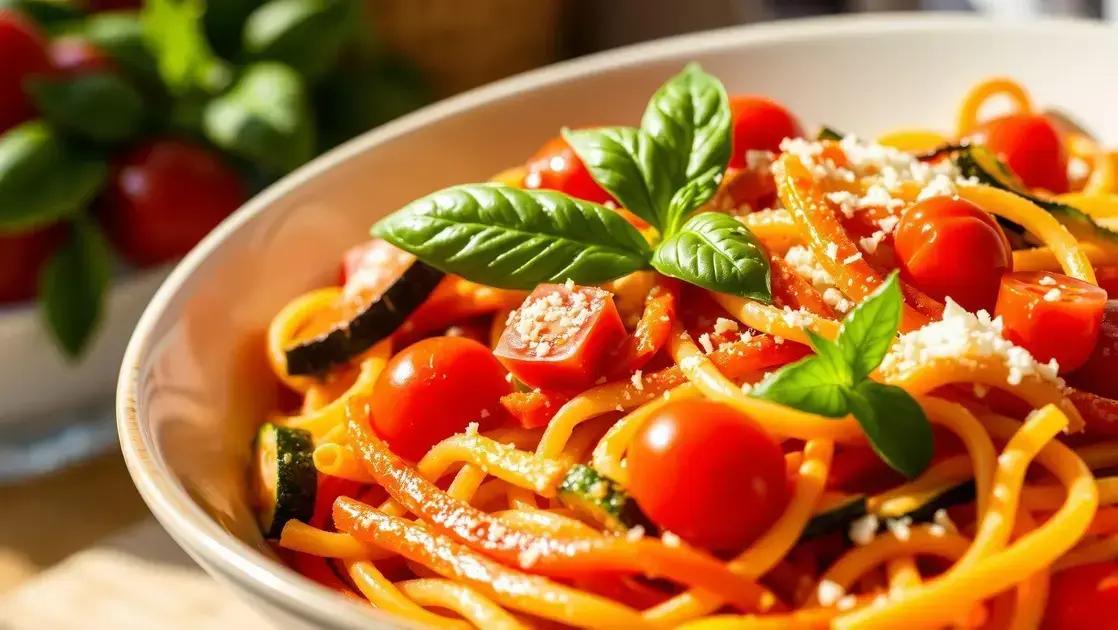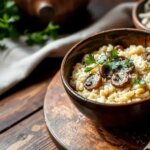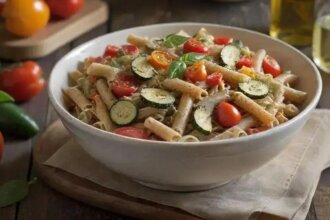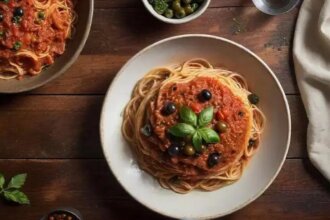
pasta primavera
Pasta primavera: discover a lighter, flavorful dish with colorful veggies. Quick, healthy, and perfect for your weekday meals!
Ingredients
Method
- Cook the pasta: In a large pot, bring water to a boil, add 1 teaspoon of salt, and cook the whole wheat pasta until al dente according to package instructions. Drain and reserve 1/2 cup of the cooking water.
- Sauté the vegetables: While the pasta cooks, heat 1 tablespoon of olive oil in a large skillet over medium heat. Add minced garlic and cook for 30 seconds.
- Add the carrot strips, zucchini, red and yellow bell peppers. Sauté for about 4-5 minutes, stirring often, until they begin to soften but remain crisp.
- Add the cherry tomatoes and cook for 2 more minutes, until they start to release juices.
- Combine: Add the drained pasta to the skillet with the vegetables. Sprinkle with the lemon zest and pour in half the lemon juice. If the mixture looks dry, add some reserved pasta water a little at a time to achieve a silky sauce.
- Finish and serve: Toss the pasta with chopped basil and half the grated parmesan cheese. Season with freshly ground black pepper and adjust salt if needed.
- Serve immediately, topped with remaining parmesan and a drizzle of olive oil, if desired. Enjoy your vibrant pasta primavera!
Notes
Pasta primavera is a classic that celebrates the beauty of fresh, colorful vegetables and quick cooking. Its versatility makes it a favorite for weeknights and family gatherings, as you can easily adapt it with whatever is in your fridge. The key to great pasta primavera is balancing just-tender veggies with a light, flavorful sauce that lets the natural sweetness of each ingredient shine.
Smart Tips for the Perfect Dish
- Cut vegetables in uniform sizes to ensure they cook evenly and retain a crisp-tender texture.
- If you’re in a hurry, prep your veggies ahead of time, storing them in airtight containers in the fridge for quick weekday assembly.
- For a gluten-free alternative, replace whole wheat pasta with your preferred gluten-free version—rice and chickpea pastas both work beautifully.
- Extra flavor boost: Sauté vegetables in a splash of vegetable broth or add a pinch of red pepper flakes for mild heat.
- If fresh basil isn’t available, a mix of chopped fresh parsley and a sprinkle of oregano creates a similarly aromatic finish.
Techniques for Great Results
- Don’t overcook the veggies! Stop cooking when they’re still vibrant and slightly firm. Overcooked vegetables can turn mushy and lose flavor.
- Reserve pasta water before draining—the starchy liquid helps bind ingredients and creates a lush, silky sauce without needing extra oil or cream.
- Lemon zest and juice add brightness. Add zest early, but only mix in the juice once off the heat to keep the flavors lively.
Serving Ideas and Variations
- Toss in grilled chicken or shrimp for a protein boost, or mix in white beans or chickpeas for a vegetarian option packed with nutrients.
- Pair with a simple green salad and crusty bread to round out the meal.
- Try different vegetables: sugar snap peas, asparagus, or baby spinach work particularly well and add seasonal variety.
- Craving a creamier texture? Add a splash of heavy cream or a spoonful of mascarpone just before serving.





